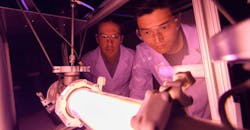Hybrid Breakers Could Make Direct Current Practical for High-Power Applications
Direct current (DC) powers flashlights, smartphones, and electric cars, but major power users depend on alternating current (AC), which cycles on and off 60 times per second. That’s because AC is simple to turn off when there’s a problem. But DC has inherent advantages over AC, including higher efficiency and the ability to carry more power over longer distances. That could be increasingly important as wind farms in rural areas produce power needed in cities. And future electric aircraft and ships are likely to be powered by high-power-density DC.
Alternating current can be shut down when the power level hits zero during a cycle—the zero-crossing point of a sine wave. This is the basis for breakers that protect modern power equipment everywhere from substations to home installations. DC lacks alternating cycles, so there are no opportune times to turn off the power.
Innovations in power electronics, piezoelectric actuators, and new insulation materials funded, in part, by a $3.3 million award from ARPA-E’s Breakers program, are poised to make high-power DC circuit breakers feasible. The hybrid circuit breaker being developed by researchers at Georgia Institute of Technology and Florida State University, for example, are expected to make breaker switching speeds 10 times faster than existing equipment
The hybrid circuit breaker under development by the research team uses stacks of large transistors that switch off the DC when necessary. Semiconductors are less efficient at conducting current than conventional mechanical switches, so under ordinary conditions, current would flow through mechanical switches. But when power must be turned off, current will be briefly routed through the power electronics until the mechanical breakers can be opened.
“We are proposing a hybrid DC circuit breaker in which the current will have two paths,” explains Lukas Graber, an assistant engineering professor at Georgia Tech. “One path will be through the semiconductors, which can interrupt the current when needed. The second path will be through mechanical switches, which will provide a much less resistive path that will be more efficient for normal operations.”
In common consumer electronics applications, transistors are too small to see and handle just a few volts. The transistors that will be used in DC switching are much larger—a square centimeter—and dozens or hundreds of them would be combined in serial or parallel to provide the capacity to switch thousands of volts. After the current moves to the solid-state transistor path, piezoelectric actuators will quickly separate the contacts in the mechanical switches before current rises too high in the transistors. Once separated, current through the transistors can be switched off.
“We need to be extremely fast,” Graber says. “We have to separate the contacts within 250 microseconds and completely break the current within 500 microseconds, just half a millisecond. That’s why we cannot use spring-loaded or hydraulic actuators common to AC breakers. Devices that rely on the piezoelectric effect can do that for us.”
The researchers expect to build a prototype that will be tested at FSU’s five-megawatt test facility within three years. The development and testing will be done in with a team of industrial partners who will ultimately transition the DC breakers to commercial use.
Direct current could be particularly useful as more renewable energy comes online. Photovoltaics in the West may still be generating power after the East Coast is in the dark. Wind turbines may be producing power in the midsection of the country while clouds cover other parts of the country. Transmitting power from one location to another could therefore become more important.
“There are large distances to be bridged with renewables,” Graber says. “When we rethink what the next grid is going to be like, DC may play a larger role.”

